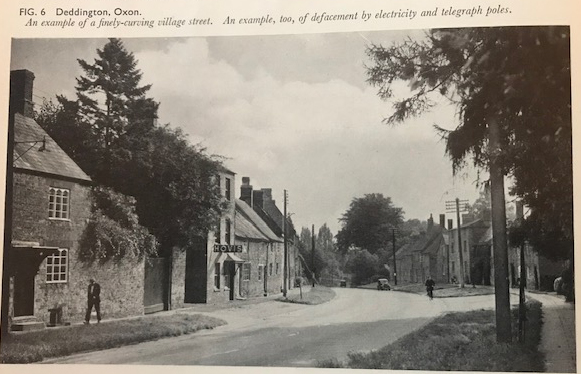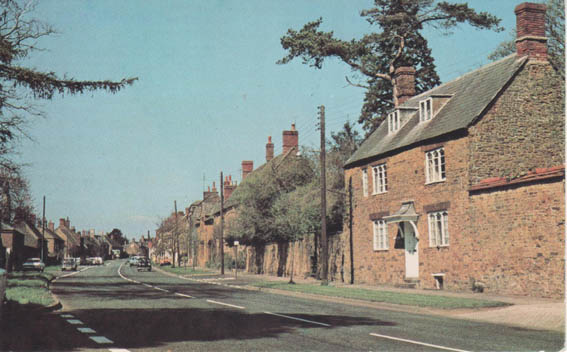Millennium Project
Rob Forsyth - assisted by Chris Day who transposed the documents for me into understandable English.
Owners and occupiers from 1756 onwards
1756. Michael Prentice. The first title deed that exists is a Conveyance in the form of a ‘Final Concord’ between Michael Prentice, plaintiff and Thomas Bates and Samuel and Ann Priest, defendants for …a messuage (main house), a cottage and a Malthouse with appurtenances . This was drawn up because Michael had acquired the property on his marriage to Ann. Prior to that it had belonged to her in her maiden name. A ‘Final Concord’ is really a sale in the form of a fictitious lawsuit. It is called this because of its opening phrase, which in the common Latin form began 'Hoc est finalis concordia ' . The plaintiff, who is the purchaser, alleges that the defendants, who are the sellers, are wrongfully in possession of his property; the sellers agree that the plaintiff is the rightful owner, and the court therefore finds in favour of the plaintiff. The advantage of a fictitious lawsuit in days before there was any central register of properly ownership was that a copy of the transaction was lodged in the court records. The document itself is called an indenture: agreements such as this were in duplicate or, more usually, triplicate on a single sheet of parchment. A wavy (i.e. indented) line was cut between each copy. The seller had one copy, the purchaser the second, and the court kept the third. Anyone seeking to forge a deed therefore faced the problem of having to fit the edges of the other two copies. For added security, the word 'cirographum' was sometimes written across the join. The document is then known as a chirograph.
Date unknown. Jane Castle, widow, Zachariah Gibbs, yeoman and Richard Gibbs, labourer. The conveyance document is missing but the words of the 1767 conveyance to Nicholas refers to the previous owners by way of identifying the property which had no name in any legal document until 1962!
1764? Mathew Strong, wheelwright paid £65 for the freehold. The conveyance document is missing; however we do know from the words in the later conveyance from Nicolas Strong to William Pritchett that a Catherine Dodd had lent Mathew £20 as a mortgage on 9 April 1764.
15/16 January 1767. Mathew sells the property to his son Nicholas Strong for 5 shillings
26/27 April 1770. Nicholas sells to William Pritchett, labourer.
6 April 1775. William purchases from John Steward, cutler, a ‘close or garden’ accessed via a door opening off Gilkes’s Close for £20. Note: The latter subsequently became Gilke’s Style and is now called The Stile.
5 November 1788. Benjamin Pritchett, labourer, buys it for £90 from William – this represents a £5 profit for William on the original purchase price of £65 plus £20 for Steward’s garden.
1800 - 1808. Benjamin carried out a number of purchases to add to the property:
18 March 1800 he purchased a cottage for £12 from Henry Bayley which adjoined his existing property.
26 February 1802 he purchased a barn and some land to the north and east of the cottage for £6-6-0d from John Bayley.
4 August 1808 he purchased a further cottage and land from John Bayley for £19. This is when Gilke’s Close is first referred to as Gilke’s Style.
Note: A map of 1808 shows that there was a cottage (No38) between the main house (No 39) and The Style fronting onto New Street situated on what is now a drive way and shrubbery. Access to the garden was therefore either exclusiveoy from The Style (see 1775 above) or possibly through the grounds of No 43, Leaden Porch farm, which had access onto Philcot Street. The existing wall between Leaden Porch and The Stile House was only built circa 1948'.
22 January 1838. Benjamin borrows £200 from Isaac Berridge, yeoman, of Somerton as a mortgage against his property on which the main house is let to Joseph Woolgrove and the cottages to William Penn and Richard Wilsden.
The 1841 Census records 2 neighbouring households in New Street headed by Benjamin Pritchett, farmer senior, 45, and Benjamin Pritchett, farmer, 21. The Reverend Cotton Risley, who lived in Deddington House, had also referred in an entry in his journal for 1840 to our opposite neighbour Pritchett. The house opposite is Leaden Porch - then a farm - immediately to the north of The Stile House and so it looks as if Father and son lived in adjoining properties. Early maps indicate that the present gardens of the two properties were then one field. As recently as 1977 The Stile House's present garden was still a small field with pig pens on the east side.
7 February 1844. Benjamin repays Isaac Berridge full capital and interest and on the 8th borrows £300 from William Beezley, yeoman, of Bloxham.
29 September 1853. Frederick Gulliver, gentleman, of Deddington purchases the property for £425 from William Beezley and Benjamin Pritchett who now lives in Barnsley Gloucestershire. The main house and ‘bake house’ are let to George Chater and the two cottages to Thomas Green and William Gibbs.
24 March 1893. Richard Page Bull, veterinary surgeon, purchases it for £325. The significantly lower sale to purchase price perhaps indicates that the property had fallen into disrepair; while the description is much the same the two cottages are now unoccupied. More about the Bull family can be found HERE
1901 Census. The family consists of Richard aged 46, wife Annie (36), daughter Frances (3) son Ronald (2), twin daughters Mona and Vera (1 month) and a 16 year old servant Lily Austin.
1st November 1918. Ronald was killed in action in France serving in the 1st battalion Northants Regiment only 10 days before the Armistice. The original wooden cross from his battlefield grave is now one of a group hanging on the north wall in the church.
3rd November 1926. Annie Bull – now a widow – and Bryan Worsley Millington, farmer, ( living in Leaden Porch House next door)who are the personal representatives of the late Richard Page Bull (d 18 December 1925), agree to vest the property in the name of Annie Bull. The description now includes a surgery and states (quite clearly) that the 2 cottages were demolished by RP Bull in 1890. However the same document says that he had purchased the property from Frederick Gulliver in 1893 – see above!
16th April 1930. Annie Bull died. Property passes to her daughter Vera.
26th January 1932. Vera Bull enters into a contract to sell the property to George Harry Beesley of North Aston, carpenter, for £550 it being occupied at the time by Francis Joseph Hyland.
10th February 1932. The Ecclesiastical Commissioners, Lords of the Dean and Chapter of Windsor, acknowledge receipt of 17s 6d as redemption of quit rent.
1st March 1932. Richard Cartwright, Lord of the Duchy Manor in Deddington, acknowledges the receipt of 17s 6d as redemption of quit rent. The house is unoccupied at the time.
7th March 1932. Christ Church College, Oxford, acknowledges the receipt of 10s 6d as redemption of quit rent. The property still has no name and is described as a freehold cottage in New Street and adjoining the style on the north afterwards in two cottages and now converted into a dwelling house.
23rd March 1932. Vera Bull sells the property to Harriet Alice Beesley, wife of (George) Harry Beesley. Albert Harper and Don Walker, both former residents, in 2018 recalled that Harry ran a carpentry and coffin making business on the property and was an Undertaker. More about the Beesley family can be found HERE
 This image is contained in the publication 'Design on Town and Village', Ministry of Housing & Local Government, HMSO, 1953. The Hovis sign marks the Course family's bakery - now a private house called 'The Bake House'.
This image is contained in the publication 'Design on Town and Village', Ministry of Housing & Local Government, HMSO, 1953. The Hovis sign marks the Course family's bakery - now a private house called 'The Bake House'.
click on image to enlarge
November – December 1962. Harriet Beesley died on 12th September and was succeeded by her daughters Constance Armour of Stoke Poges and Margaret Millington* of Brackley who sell the property in December to Mrs Maria Jones of Islington. The house is referred to as the freehold property now known as The Stile House – this is the first reference to its present name. We were told by Betty Hill (the owner of Leaden Porch House since 1965) that ours and her garden had always been open to each other until her previous occupant, Rear Admiral Berthon, had built a wall to divide them and establish his boundary. So the wall was probably built by the Admiral in 1962 to define his boundary when Harriet's daughters sold the property.
*Margaret's husband was Bryan Millington a cousin of the Bryan Millington who lived in Leaden Porch House 1899-1940 and farmed the land of the same name.
Maria Jones carried out extensive modernization and renovation work to the house.
1st April 1969. The property is conveyed to Diana Elizabeth Morel.
4th July 1975. The property is conveyed to Jeremy Baker, Clerk to Oxford City Council.
 1st April 1977. The property is conveyed to Robert and Maureen Forsyth. The image on the left is from a postcard contemprory with the purchase and littel chnaged since the 1953 image above.
1st April 1977. The property is conveyed to Robert and Maureen Forsyth. The image on the left is from a postcard contemprory with the purchase and littel chnaged since the 1953 image above.
click on image to enlarge
It has subsequently been listed Grade II and, subject to the restrictions imposed by this listing, further modernisations and an extension to the east (to include some of the area previously occupied by the former cottages demolished by Ronald Bull) have been carried out. The corrugated iron roof on the garage (former barns) has been replaced by thatch and two cut stone archways with traditional barn doors replaced the 1960's style 'up and over' metal doors. Approx 1/3rd of acre of land formerly belonging to Leadenporch has been added as an extension to the garden.